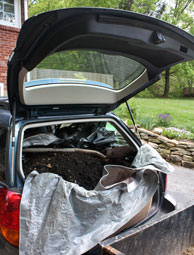
Courtesy Briggs & Stratton
Briggs & Stratton Storm Responder 5500W/8250W |
If you weren’t one of the 3.8 million homes without power as a result of storms during the first three months of 2010, be thankful. Storm-felled trees and ice can take power lines down with them, and lesser-populated areas are often lower on the power-restoration priority list. Sometimes restoration can take days, a week or even more, as was the case earlier this year with winter storms in California, New Jersey, Pennsylvania, Kentucky, southern Maine and New Hampshire.
“The aging utility grid and severe weather are combining to cause outages that are more frequent and last longer,” says Cathy Olig, senior channel manager of Generac, the world’s largest manufacturer of automatic standby generators. While worst-case impacts of power outages may include water pipes bursting in the winter in the North or mold and mildew damage in the summer in the South, power outages year-round can turn well-stocked freezers into compost and worse. Extended power outages are even more painful if your income stream depends on a home office, heated greenhouse, irrigation or other power-needy devices.
Avoiding these problems, as well as powering modern amenities, such as fresh water, are all reasons to install your own emergency power resource. There are many generator options available, from tractor PTO-powered and gas- and diesel-powered portable generators to permanently installed standby generators powered by propane or natural gas. Picking the right generator for you is as much a matter of knowing yourself as it is understanding generators.
Generator Options
“Which generating unit is best for you depends on what you want to power,” says Olig. “Do you want a solution that is hands-free and ready to go when the power goes out or a portable system you move into place as needed?”
Melanie Tydrich of Kohler Power Systems, which has manufactured generator sets since 1920, says, “We recommend having an electrical contractor come in and review your power needs and electrical system before making a generator purchase. … They may recognize things you didn’t think about.”
Once you identify your needs, picking the right generator is relatively easy. Total the watts needed to power necessary items in the event of a power outage. If wattage information isn’t available, use this formula: Volts x Amps = Watts. This will give you the power production necessary to keep the chosen systems running.
Of course, few things in life are ever truly simple. Motorized appliances, such as freezers, refrigerators and air conditioners—anything that has a pump or compressor—require two to four times the running watts just to start. Thus, generator size has to be adjusted for start-up draw. Look for the peak motor-starting kVA rating when evaluating a generator.
“A very high peak motor-starting kVA rating lets you use a smaller generator to power up multiple high-start-up motors,” says Tydrich. “A large appliance or farm equipment may not require a lot of wattage to run but will need it for the start-up.”
Portable Generators

Courtesy John Deere
John Deere Compresserator |
Generator options include portable or standby. The big difference between the two is versatility of portables and ease of use of standbys. Portables are ideal if you have multiple needs, such as remote well pumps along with a few key household circuits, like freezers or refrigerators you can power up periodically to maintain the desired temperatures. When not needed for emergency power around the house, portable generators can provide temporary power at a campsite, worksite or remote cabin.
Portables can be on wheels or skids for mounting in a pickup or even on the back of a UTV. Larger cart-mounted portables with motors or PTO power are also available with sufficient power for an entire house or even a farm. PTO-powered generators would seem ideal for farm use.They eliminate the need and cost of a dedicated motor. Tractors generally see year-round use, while a motor for a generator needs to be tested regularly to ensure it will work when needed. The downside is that while powering a generator, the tractor is not available for other storm-related work, such as removing snow or downed trees.
For added versatility, some common farm tools, such as many portable AC/DC welders, can also be used for emergency power. The John Deere Compresserator consists of a combination motor/compressor/generator. It’s available in wheel or skid models with power ratings of 1,600 to 4,000 watts. Buyers can pick from 8- and 30-gallon capacity tanks and single- or two-stage compressors as needed for particular applications.
“Contractors and farmers appreciate the convenience of an air compressor and generator in the same package,” says Chris Spyrow, product manger for John Deere. “It takes care of two needs with a single machine and single motor. You cut costs up front and in maintenance later.”
The Compresserator is also available equipped with an inverter. While inverters can double the cost of a portable generator, they produce a higher-quality power, run quieter, and throttle up and down as needed, saving fuel.
Page 1 | 2















